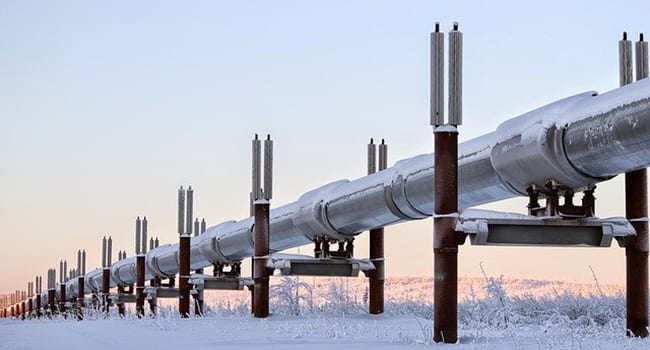 Over the past few weeks, we’ve heard a lot about the Coastal GasLink pipeline project route in northern B.C. Some historical perspective might inform the debate.
Over the past few weeks, we’ve heard a lot about the Coastal GasLink pipeline project route in northern B.C. Some historical perspective might inform the debate.
We’ve read that the Wet’suwet’en hereditary chiefs have a favoured alternate route but for various reasons the company can’t support it.
Given that I haven’t been on site and don’t know the local parameters, I can hardly offer any advice to resolve the issue. But I can offer the history of a pipeline route relocation process I had responsibility for in the Sahtu Region of the Western Arctic. The area is the heartland of the Sahtu Dene First Nations, whose communities include Colville Lake, Deline, Fort Good Hope, Norman Wells and Tulita.
In 1984, I was the manager of northern programs and community affairs for the Polar Gas Project, which was a consortium based in Toronto that aspired to build the $6-billion Mackenzie Valley gas pipeline. The project was a 52-inch, high-pressure natural gas pipeline that would run from the Mackenzie delta gas fields to Alberta, where it would tie into the Alberta pipeline network.
Part of my job entailed taking the first draft of the pipeline right-of-way drawings to all of the Sahtu communities and explaining it in detail. Our goal was to win community support, prior to the looming National Energy Board hearings, for the chosen route.
While I reported to Polar Gas’s CEO, the design and route selection process was run by the vice-president of engineering for the project. As such, my initial work, as far as route selection went, consisted of trying to win approval of a fait accompli. The VP was adamant that his team had chosen the safest, most technically adept and cost-effective route possible. In his opinion, it was my job to sell this proposition to the Sahtu Dene.
I booked a trip to Fort Good Hope, the political headquarters of the Sahtu Dene who, in 1921, had signed Treaty 11 (along with the Gwich’in and Tlicho Dene). Weak implementation of the treaty terms, particularly with regard to reserves and land claims, had led to considerable disagreement as to how it actually impacted Aboriginal title.
I was invited to speak at a community assembly in Fort Good Hope by Chief Antoine Mountain. I arrived the day before the assembly, and spent considerable time putting up maps and facility drawings in the community hall. About 250 community participants were expected, ranging from children to elders.
The event began at 7 p.m. and it took me about two hours to complete the presentation. I figuratively walked the audience down the right-of-way from north to south, explaining where river barges would off-load pipe sections, where construction gravel would be excavated, where work camps would be located, where turbines (jet engines really) would be installed to move the gas through the line, and provided detail about the construction process.
I finished and looked up at my audience. To a person they sat upright in their seats, completely quiet. I asked several times if there were any questions. Not a hand went up. And so I thanked everyone for coming and began to pack up my materials, somewhat surprised by the response I had just received.
Chief Mountain walked up to my table at the front of the emptying room.
“Mr. Robinson, the first thing I’m going to tell you is that in Dene culture when people hear something they strongly disagree with, they become silent. Don’t read the silence in this room tonight as approval of what you told us, or of your project. Much of what you revealed was hurtful and insensitive.”
I was shocked.
“I will now explain to you some of the problems you face,” the chief continued.
“First of all, your river barge off-loading area is right at our most important net-fishing spot for whitefish. That will not be allowed.
“Your gravel borrow area is our community’s winter graveyard. People have been laid to rest there for centuries.
“You’re proposing to locate 800 men in a construction camp just a few miles from our community. The mothers here will not allow that.
“Your pipeline turbine is located next to the old folks home. Why do you want to disturb them with that jet noise?
“Your right-of-way is also too close to our community. What if there is an explosion?”
It was clear that our route selection process had been a disaster from a community perspective. I was angry at myself for not being more aware from the start. It was too late to call my boss, so I went up the hill to my cabin and had a fitful sleep.
Next week, Part 2: Selecting a culturally appropriate pipeline route with local input and a refined sense of Dene stewardship of Aboriginal title.
Mike Robinson has been CEO of three Canadian NGOs: the Arctic Institute of North America, the Glenbow Museum and the Bill Reid Gallery. Mike has chaired the national boards of Friends of the Earth, the David Suzuki Foundation, and the Canadian Parks and Wilderness Society. In 2004, he became a Member of the Order of Canada.
The views, opinions and positions expressed by columnists and contributors are the author’s alone. They do not inherently or expressly reflect the views, opinions and/or positions of our publication.

